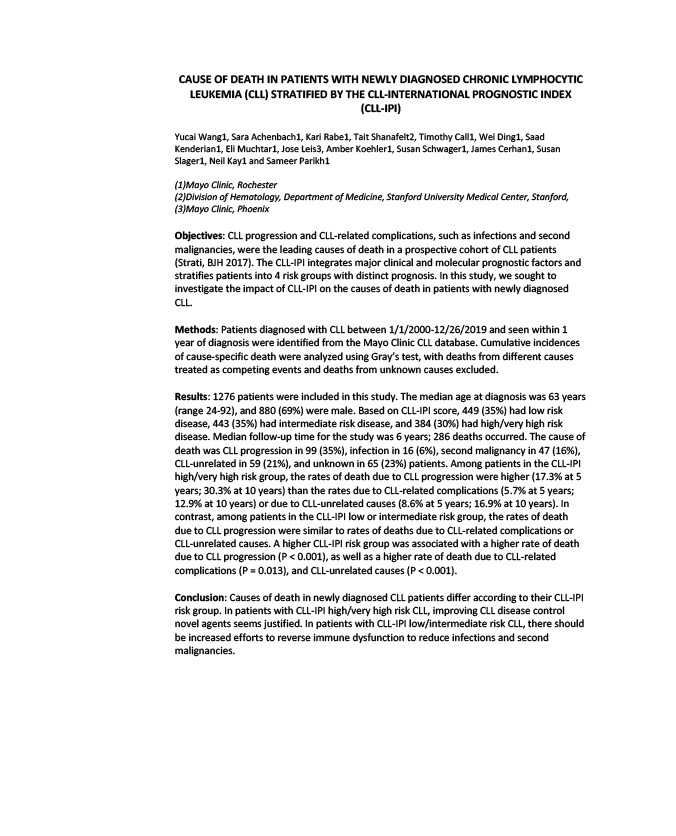
CAUSE OF DEATH IN PATIENTS WITH NEWLY DIAGNOSED CHRONIC LYMPHOCYTIC
LEUKEMIA (CLL) STRATIFIED BY THE CLL-INTERNATIONAL PROGNOSTIC INDEX
(CLL-IPI)
Yucai Wang1, Sara Achenbach1, Kari Rabe1, Tait Shanafelt2, Timothy Call1, Wei Ding1, Saad
Kenderian1, Eli Muchtar1, Jose Leis3, Amber Koehler1, Susan Schwager1, James Cerhan1, Susan
Slager1, Neil Kay1 and Sameer Parikh1
(1)Mayo Clinic, Rochester
(2)Division of Hematology, Department of Medicine, Stanford University Medical Center, Stanford,
(3)Mayo Clinic, Phoenix
Objectives: CLL progression and CLL-related complications, such as infections and second
malignancies, were the leading causes of death in a prospective cohort of CLL patients
(Strati, BJH 2017). The CLL-IPI integrates major clinical and molecular prognostic factors and
stratifies patients into 4 risk groups with distinct prognosis. In this study, we sought to
investigate the impact of CLL-IPI on the causes of death in patients with newly diagnosed
CLL.
Methods: Patients diagnosed with CLL between 1/1/2000-12/26/2019 and seen within 1
year of diagnosis were identified from the Mayo Clinic CLL database. Cumulative incidences
of cause-specific death were analyzed using Gray’s test, with deaths from different causes
treated as competing events and deaths from unknown causes excluded.
Results: 1276 patients were included in this study. The median age at diagnosis was 63 years
(range 24-92), and 880 (69%) were male. Based on CLL-IPI score, 449 (35%) had low risk
disease, 443 (35%) had intermediate risk disease, and 384 (30%) had high/very high risk
disease. Median follow-up time for the study was 6 years; 286 deaths occurred. The cause of
death was CLL progression in 99 (35%), infection in 16 (6%), second malignancy in 47 (16%),
CLL-unrelated in 59 (21%), and unknown in 65 (23%) patients. Among patients in the CLL-IPI
high/very high risk group, the rates of death due to CLL progression were higher (17.3% at 5
years; 30.3% at 10 years) than the rates due to CLL-related complications (5.7% at 5 years;
12.9% at 10 years) or due to CLL-unrelated causes (8.6% at 5 years; 16.9% at 10 years). In
contrast, among patients in the CLL-IPI low or intermediate risk group, the rates of death
due to CLL progression were similar to rates of deaths due to CLL-related complications or
CLL-unrelated causes. A higher CLL-IPI risk group was associated with a higher rate of death
due to CLL progression (P < 0.001), as well as a higher rate of death due to CLL-related
complications (P = 0.013), and CLL-unrelated causes (P < 0.001).
Conclusion: Causes of death in newly diagnosed CLL patients differ according to their CLL-IPI
risk group. In patients with CLL-IPI high/very high risk CLL, improving CLL disease control
novel agents seems justified. In patients with CLL-IPI low/intermediate risk CLL, there should
be increased efforts to reverse immune dysfunction to reduce infections and second
malignancies.